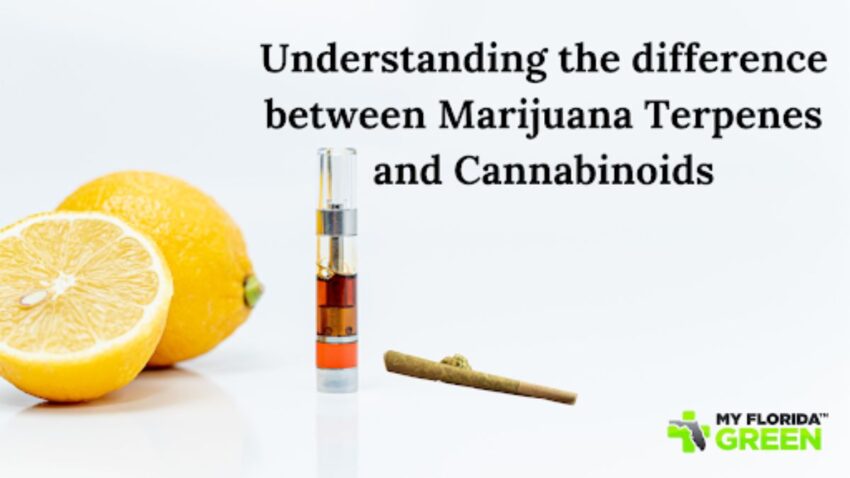Medical Marijuana terpenes and cannabinoids are two essential chemicals in the realm of cannabis that play diverse roles in defining its effects and medicinal characteristics. Terpenes give the distinct aroma of different cannabis strains. In contrast, cannabinoids are active chemical components that contribute to the plant’s euphoric and therapeutic properties.
While both add to the overall cannabis experience, their methods and roles are different.
Understanding the differences between marijuana terpenes and cannabinoids is critical for optimizing the potential benefits of cannabis usage and advancing medical research and commercial development. Also, your medical marijuana card in St. Petersburg can ease your marijuana journey.
This article digs into the essential differences between cannabinoids and terpenes and their various roles in cannabis consumption.
Terpenes – A Comprehensive Overview
Terpenes are the aromatic constituents in a variety of plants. However, they are mainly associated with cannabis due to their high concentration in this plant. These aromatic chemicals are responsible for the distinctive scents of cannabis, pine, lavender, and fresh orange peels.
Terpenes defend plants from animal grazing and pathogenic microorganisms in nature. Moreover, terpenes may provide certain health benefits for the human body. As cannabis gets legalized in Florida, experts are conducting more studies into its potential advantages.
Terpenes in marijuana are produced in the glandular trichomes. They interact with other cannabinoids to enhance or modulate their effects. Terpenes are thought to have medicinal characteristics and may contribute to the distinct effects produced by various marijuana strains.
Types of Terpenes
Marijuana contains several terpenes, each contributing to the distinct scents and possible effects of various cannabis strains. Given are the most common terpenes in marijuana:
- Terpene-Limonene
This terpene is responsible for the citrus aroma of certain cannabis strains. Limonene has mood-boosting and anti-anxiety properties.
- Myrcene
It is present in high concentrations in the cannabis plant. It adds to the calming and relaxing traits commonly associated with Indica strains.
- Pinene
It has a strong pine scent and has been linked to its role in mental alertness, memory retention, and anti-inflammatory qualities.
- Terpinolene
This terpene has a rich aroma, including tones of pine, floral, and herbal smells. Its therapeutic properties aid the body’s fight against cancer.
These are just a few examples of the various terpenes found in marijuana, each of which contributes to the overall aroma profile and may influence the effects of different strains. The use of terpenes, along with cannabinoids, provides distinct cannabis-related experiences.
Understanding Cannabinoids
Cannabis is a unique plant with several health benefits. It consists of vital cannabinoids like delta-9-tetrahydrocannabinol (THC) and cannabidiol (CBD).
Tetrahydrocannabinol (THC) and Cannabidiol (CBD) influence the brain receptors to produce healing effects. These cannabinoids are helpful against various medical issues, including pain management, anxiety, mental disorders, and even skin conditions.
Experienced clinicians use these cannabinoids in Medical Marijuana to design individualized treatment strategies based on patients’ medical problems. This opens up new options and pathways for helping patients. However, the benefits must outweigh the risks to maximize the health effects of this soothing drug.
Availability of Cannabis Products
Several marijuana products are available now, each with a distinct effectiveness, mode of action, and method of administration. As more research advances, the medicinal usage of these products may expand. If you want to use medical marijuana to manage your symptoms, contact the best marijuana doctors in St. Petersburg.
Read on to learn how terpenes and cannabinoids interact with the body.
Therapeutic Response of Terpenes and Cannabinoids
Terpenes and cannabinoids connect with the Endocannabinoid System (ECS) via various methods. They alter the physiological processes in the body and contribute to the overall effects of cannabis ingestion.
- THC and CBD
The cannabis compounds bind to cannabinoid receptors in the endocannabinoid system. THC interacts with CB1 receptors in the brain to produce intoxicating effects. Whereas CBD impacts both CB1 and CB2 receptors, resulting in therapeutic benefits.
Cannabinoids can regulate the production and release of endocannabinoids, such as anandamide and 2-arachidonoylglycerol (2-AG), by interacting with enzymes involved in their synthesis and breakdown within the Endocannabinoid System (ECS).
- Modulation of Receptors
Terpenes can affect the ECS indirectly by influencing cannabinoid receptors. Some terpenes, such as myrcene, may increase cannabinoids’ ability to bind to the CB1 receptor, potentially amplifying THC’s overall impact.
- Enzyme Inhibition
Terpenes can block enzymes that break down endocannabinoids. These enzymes include fatty acid amide hydrolase (FAAH) and monoacylglycerol lipase (MAGL). By blocking the enzymes, terpenes can affect the longevity of endocannabinoids, extending their effects on the ECS.
- The Entourage Effect
The entourage effect is a phenomenon where terpenes and cannabinoids collaborate synergistically to enhance the overall effects of cannabis. Terpenes can increase cannabinoid absorption and affect their activity inside the ECS, leading to the different healing effects felt by cannabis users.
Overall, terpenes and cannabinoids uniquely interact with the ECS. While cannabinoids bind to ECS receptors directly, terpenes regulate the system indirectly, impacting the effects and medicinal potential of cannabis.
The complex interaction of these substances emphasizes the need to consider the entire range of marijuana’s components while researching its medicinal uses and overall influence on the human body.
Visit a Medical Marijuana Dispensary
If you are concerned about the type and strains of medical cannabis, you must contact state-certified doctors in the relevant field. They can guide you to use your MMJ card to buy Marijuana Naples products from the best marijuana dispensary in St. Petersburg.
The Takeaway
Terpenes and cannabinoids produce therapeutic effects on the human body. They have significant roles in the aromatic and healing nature of the cannabis plant. After you consult a licensed medical marijuana doctor in St. Petersburg, you can begin using this drug conveniently.


